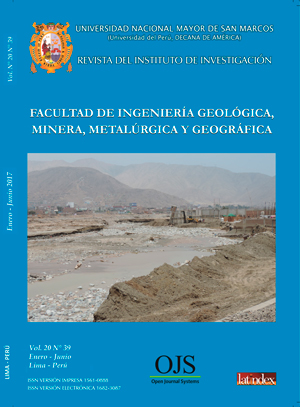Isolation of native fungi for handling of plant parasitic nematodes of tomato’ rhizosphere
DOI:
https://doi.org/10.15381/iigeo.v20i39.14178Keywords:
Nematophagous fungi, nematicide, biological control, bait nematodesAbstract
41 native fungi were isolated from five agro ecosystems in the provinces of Chimborazo (4 samples) and Tungurahua (1 sample). The main genera found were for Aspergillus, Penicillium, Trichoderma, Mucor, Alternaria, Fusarium, Acremonium, Paecylomices among others. Using the technique of bait nematodes (Wyborn et al. 1969), isolates were compared with a suspension of 90 nematodes, divided into 3 groups of 30 individuals. The nematode species used corresponded to Passalorus present in feces rabbit. after 96 hours, the number of parasitized or inactive nematodes were counted. The data obtained were analyzed by nonparametric tests (test kruskalwallis) results showed highly significant (<0.0001), so a comparison of medians were performed, according to the ranking. The native isolates GUC, GUE, UTD, GUL, SLJ were the best statistically, followed by the PAD, SLB, SLE, SJA strains. Pathogenicity tests were conducted using completely randomized design (CRD) with three replications. For this purpose, plant parasitic nematodes Meloidogyne galls isolated from tomato, properly sanitized and homogenized was used. Concentrations of 108 spores each of the strains native fungi and nematodes per 40 each placed three replications. Nematode data were recorded at 24, 48, 72 and 96 hours; data obtained underwent a transformation Bliss, used to normalize percentages. Analysis of variance showed that there were highly significant (<0.0001) for treatment, not for treatment for x Time interaction. Tukey test at 5% for the treatment factor, determined that the GUC (73.96%), SLB (70.21%) and SLE (66.67%) isolates are those with the highest percentage of inactivity nematodes and belonged to the genus Trichoderma, Paecilomyces and Acremonium respectively.Downloads
Published
Issue
Section
License
Copyright (c) 2017 Norma Erazo, Jhonny Guaminga, Carlos Carpio

This work is licensed under a Creative Commons Attribution-NonCommercial-ShareAlike 4.0 International License.
AUTHORS RETAIN THEIR RIGHTS:
a. Authors retain their trade mark rights and patent, and also on any process or procedure described in the article.
b. Authors retain their right to share, copy, distribute, perform and publicly communicate their article (eg, to place their article in an institutional repository or publish it in a book), with an acknowledgment of its initial publication in the Rev. Inst. investig. Fac. minas metal cienc. geogr.
c. Authors retain theirs right to make a subsequent publication of their work, to use the article or any part thereof (eg a compilation of his papers, lecture notes, thesis, or a book), always indicating the source of publication (the originator of the work, journal, volume, number and date).






